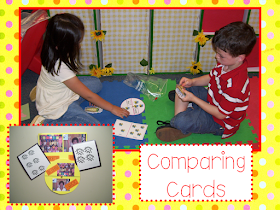So What is Subitizing?
Subitizing is the ability to instantly recognize the amount of objects without actually counting them. When I was a young teacher, Math Their Way was THE math curriculum. Math Their Way is where I learned about the importance of teaching subitizing. Mary had this game called "Say it Fast". To play the game you quickly flashed a card with a set of dots. Then, the children would tell you how many dots--without actually counting.Subitizing helps children to discover essential properties of number. They learn important skills such as conservation, unitizing, counting on, composing and decomposing number, addition, subtraction, and place value!
When teaching children to subitize, we invite them to take a "snapshot". We do this by showing the children a collection of objects for a few seconds and then the children take a snapshot to develop a mental image of the set.
Ten Easy Ways to Teach Subitizing
1.Build It!- Give children a set of manipulatives (1-6).
- Ask the children to arrange their set of manipulatives into a configuration.
- Ask, "How many? How do you know?"
- Now, using the same manipulatives, invite the children to show you another arrangement for that same number.
- This conceptual game scaffolds the children to show you multiple representations of the same number.
- The whole lesson focuses on that one number! Next time you play, you can pick a new number.
- Play concentration games and match different configurations for the same number.
- To play the first time, make a set of dot cards for numerals 1-6 using the traditional configuration of dots (like the dice). Reproduce 2 sets of the cards.
- Lay the cards face down, invite the children to turn over two cards. Do they match? Do they have the same number of dots?
- Once they master this, make two sets of dot cards for numerals 1-6 with DIFFERENT configurations.
- Lay the cards face down and invite the children to turn over two cards. Do they have the same number of dots? How do you know?
- Once they master this, make two sets of dot cards for numerals 1-6 with DIFFERENT configurations and different colors of dots. For example, one set might have 3 red dots and 2 blue dot. The matching card might have 1 red dot and 4 blue dots.
- Lay the cards face down and invite the children to turn over two cards. Do they have the same number of dots? How do you know?
- Give the children a card with a set of dots. Invite them to add one more dot. Ask, "How Many?"
- Once they master this game, show the children the card with the set of dots. Ask, "What number is one more? How do you know." This requires them to have a mental image of the new set.
- Lay dot cards on the floor. Say a number. See how quickly children can find the set.
- Begin with the traditional configuration of dots for each number.
- Then, move to a nontraditional configuration of dots.
- Finally, use a nontraditional configuration of dots and different colors of dots.
- Any games that use a dice are great for teaching subitizing.
- Consider using a blank cube to make the dots in a nonstandard configuration.
- Here are a few games my kids enjoy.
- Roll a dice.
- Move a rabbit that many spaces.
- You can move one rabbit or split the roll between two or three rabbits.
- The object of the game is to get all of the rabbits to the top of the game board.
- Lay a number line down.
- Place a small counter or clip art picture on top of each numeral.
- Roll a dice.
- Move the game piece on the game board and remove the small counter.
- Roll again.
- The child chooses to move the piece forward or backward on the number line.
- The object of the game is to capture all of the small counters.
- Dominoes are another great, cheap resource for teaching subitizing.
- Here are a few games my kids enjoy.
- Make the parking lot game board.
- Give the children a set of dominoes.
- Invite the children to sort the dominoes onto the game board.
- The object is to "subitize", however, if they can not they will count!
- Make a blank domino book for each child.
- Lay the dominoes face down.
- Invite the children to turn over a domino and say how many dots.
- Reproduce the set using a bingo dotter.

- Give the children a number.
- Make domino cards with one side blank.
- Invite the children to decide how many more they need to make "their" number.
- Use playdough to make the balls to get to their number.
- Cards! What a gold mine!
- You might want to consider cutting the numerals in the corner of the cards. This forces the children look at the configuration instead of the numeral.
- Lay a deck of cards between two children.
- Invite each child to turn over a card.
- Subitize and compare for more and less.
- Lay the cards on the more and less game board.
- Whoever had less, spin the more and less spinner.
- Wherever it lands determines who gets the cards.
Here are some great topic lessons using fives frames.
·
Flash the
cards quickly. Ask, “How many dots?” How do you know? Repeat.
·
Reproduce
and laminate the blank fives frame game board and the counting pieces. Give
each child a blank fives frame game board and some of the counters. Red and
Blue dots and spurs and hats are included in the packet. Flash a card. Say,
“Make your fives frame board have one more than my board.” One less..., The
same number..., etc. Repeat.
·
Flash the
fives frame card. Invite the children to make their fives frame look like your
fives frame. Now write an addition sentence on a white board to match the fives
frame. Repeat.
·
Flash a
fives frame card. Invite the children to make their board look like yours. Now
using their counters, show the sum in a different combination. Repeat.
9. Tens FramesHere are some great topic lessons using tens frames.
·
Flash the
cards quickly. Ask, “How many dots?” How do you know? Repeat.
·
Reproduce
and laminate the blank tens frames game board and the counting pieces. Give
each child a blank tens frames game board and some of the counters. Red and
Blue dots and spurs and hats are included in the packet. Flash a card. Say,
“Make your tens frames board have one more than my board.” One less..., The
same number..., etc. Repeat.
·
Flash the
tens frames card. Invite the children to make their tens frames look like your
tens frames. Now write an addition sentence on a white board to match the tens
frames. Repeat.
·
Flash a
tens frames card. Invite the children to make their board look like yours. Now
using their counters, show the sum in a different combination. Repeat.
10. Rekenreks
Here are some great topic lessons using rekenreks.
·
Flash the
cards quickly. Ask, “How many dots?” How do you know? Repeat.
·
Flash the
rekenrek card. Invite the children to make their rekenrek look like your
rekenrek. Now write an addition sentence on a white board to match the
rekenrek. Repeat.
·
Flash a
rekenrek card. Have the children make their rekenrek look like your rekenrek.
Write on the white board how many dots on each row. Circle the number that is
more..., less..., etc. Repeat.
If you want to know more about rekenreks, check out this blog post.Rekenreks, Smart Boards, and Chicago?
If you are looking for subitizing and other number activities you might want to check out these resources:














Kim, this was a goldmine of ideas!Thanks so much for sharing!!! LOVE!
ReplyDeleteThanks so much. Quick question. When I click on the link for Math Game Bundle 1, it puts me to the same place as Number Math Game Bundle. Are these 2 the same?
ReplyDeleteJennifer--Thanks for the heads up! I fixed the link. They are two different units.
ReplyDeleteThis comment has been removed by a blog administrator.
ReplyDeleteThis comment has been removed by a blog administrator.
ReplyDeleteThis comment has been removed by a blog administrator.
ReplyDeleteThis comment has been removed by a blog administrator.
ReplyDeleteThis comment has been removed by a blog administrator.
ReplyDeleteThis comment has been removed by a blog administrator.
ReplyDeleteThis comment has been removed by a blog administrator.
ReplyDeleteThis comment has been removed by a blog administrator.
ReplyDeleteThis comment has been removed by a blog administrator.
ReplyDeleteThis comment has been removed by a blog administrator.
ReplyDeleteThis comment has been removed by a blog administrator.
ReplyDeleteThis comment has been removed by a blog administrator.
ReplyDeleteThis comment has been removed by a blog administrator.
ReplyDeleteThis comment has been removed by a blog administrator.
ReplyDeleteThis comment has been removed by a blog administrator.
ReplyDeleteThis comment has been removed by a blog administrator.
ReplyDeleteThis comment has been removed by a blog administrator.
ReplyDeleteThis comment has been removed by a blog administrator.
ReplyDeleteThis comment has been removed by a blog administrator.
ReplyDeleteThis comment has been removed by a blog administrator.
ReplyDeleteThis comment has been removed by a blog administrator.
ReplyDeleteThis comment has been removed by a blog administrator.
ReplyDeleteThis comment has been removed by a blog administrator.
ReplyDeleteThis comment has been removed by a blog administrator.
ReplyDeleteThis comment has been removed by a blog administrator.
ReplyDeleteThis comment has been removed by a blog administrator.
ReplyDeleteThis comment has been removed by a blog administrator.
ReplyDeleteThis comment has been removed by a blog administrator.
ReplyDeleteThis comment has been removed by a blog administrator.
ReplyDeleteThis comment has been removed by a blog administrator.
ReplyDeleteThis comment has been removed by a blog administrator.
ReplyDeleteThis comment has been removed by a blog administrator.
ReplyDeleteThis comment has been removed by a blog administrator.
ReplyDeleteThis comment has been removed by a blog administrator.
ReplyDeleteThis comment has been removed by a blog administrator.
ReplyDelete